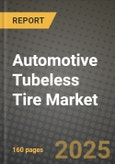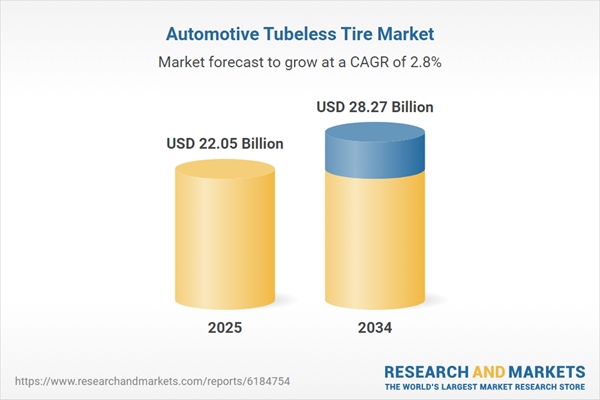Automotive Tubeless Tire Market
Automotive tubeless tires have become the standard in modern vehicle manufacturing due to their convenience, safety, and cost-effectiveness. These tires eliminate the need for an inner tube by using an airtight seal between the tire and the rim, which provides improved puncture resistance, easier maintenance, and better fuel efficiency compared to traditional tube tires. Tubeless tires are widely used in passenger cars, commercial vehicles, two-wheelers, and electric vehicles. The automotive tubeless tire market is experiencing robust growth driven by increasing vehicle production, rising consumer demand for safer and more fuel-efficient vehicles, and advancements in tire technologies. Additionally, the adoption of tubeless tires is supported by growing awareness regarding vehicle performance, safety standards, and environmental concerns related to tire disposal. Key trends in the market include the development of eco-friendly and energy-efficient tires, integration of advanced rubber compounds, and the growth of smart tire technologies, which enable real-time monitoring of tire pressure, temperature, and wear levels. The competitive landscape of the automotive tubeless tire market includes leading global players, regional tire manufacturers, and innovative startups focusing on new tire designs, sustainability, and performance optimization. Challenges in the market include fluctuating raw material prices, supply chain constraints, and the need for ongoing research and development to meet evolving consumer and regulatory demands. Overall, the automotive tubeless tire market is poised for growth as vehicle manufacturing continues to increase and innovations in tire technologies progress.Automotive Tubeless Tire Market Key Insights
- Safety and convenience remain primary drivers.
- Fuel efficiency through low rolling resistance.
- Technological advancements in tire materials.
- Integration of smart tire technologies.
- Demand for eco-friendly and sustainable tires.
- Strong growth in electric vehicle (EV) adoption.
- Growing preference in developing regions.
- Innovations in tire repair and maintenance solutions.
- Tire retreading and extended lifespan options.
- Fluctuations in raw material prices.
Automotive Tubeless Tire Market Reginal Analysis
North America
In North America, the demand for tubeless tires is primarily driven by the growing adoption of passenger vehicles, light trucks, and electric vehicles. Regulatory requirements for fuel efficiency and safety standards have further increased the adoption of tubeless tires. The market is also witnessing advancements in tire technologies, with major manufacturers investing in research and development for smart tire solutions. Strong infrastructure and widespread distribution networks support market growth.Europe
Europe is experiencing strong growth in the tubeless tire market, especially driven by the increasing demand for eco-friendly and energy-efficient vehicles. Regulations around emissions and sustainability are pushing manufacturers to produce low-rolling-resistance tires. Additionally, the growing adoption of electric vehicles and the rise in car-sharing services are contributing to the demand for tubeless tires. The region also focuses heavily on innovation in tire materials and smart technologies.Asia-Pacific
The Asia-Pacific region dominates the global automotive tubeless tire market due to its large automotive production base, particularly in China, India, and Japan. The growing demand for vehicles, rapid urbanization, and increasing disposable income are the primary drivers. Additionally, the region is home to several key tire manufacturers, further strengthening its market position. Increasing awareness about fuel efficiency and safety is also boosting the demand for tubeless tires in the region.Middle East & Africa
The Middle East & Africa region is witnessing steady growth in the automotive tubeless tire market, driven by expanding automotive production in countries like Saudi Arabia, South Africa, and the UAE. The demand for vehicles, particularly light trucks and SUVs, is increasing, along with the growing trend of urbanization. The market is also influenced by oil price fluctuations, which impact consumer purchasing power and vehicle ownership.South & Central America
In South & Central America, the automotive tubeless tire market is growing due to increasing vehicle ownership and the expansion of transportation networks. The rising demand for passenger vehicles and commercial fleets, coupled with the region’s evolving regulatory landscape, is contributing to market growth. Countries such as Brazil and Argentina are expected to be major contributors to the growth, with the increasing adoption of tubeless tires driven by cost-effectiveness and performance benefits.Automotive Tubeless Tire Market Segmentation
By Type
- Radial
- Bias
By Vehicle
- Two-Wheeler
- Passenger Car
- Commercial Vehicle
By Distribution Channel
- Original Equipment Manufacturer (OEM)
- Aftermarket
Key Market players
Bridgestone Corporation, The Goodyear Tire & Rubber Company, Michelin Group, Continental AG, Pirelli & C. S.p.A., Sumitomo Rubber Industries Ltd., Hankook Tire & Technology Co., Ltd., Yokohama Rubber Company Ltd., Toyo Tire & Rubber Co., Ltd., CEAT Limited, MRF Limited, Apollo Tyres Ltd., Kumho Tire Co., Inc., Cooper Tire & Rubber Company, Maxxis InternationalAutomotive Tubeless Tire Market Analytics
The report employs rigorous tools, including Porter’s Five Forces, value chain mapping, and scenario-based modelling, to assess supply-demand dynamics. Cross-sector influences from parent, derived, and substitute markets are evaluated to identify risks and opportunities. Trade and pricing analytics provide an up-to-date view of international flows, including leading exporters, importers, and regional price trends.Macroeconomic indicators, policy frameworks such as carbon pricing and energy security strategies, and evolving consumer behaviour are considered in forecasting scenarios. Recent deal flows, partnerships, and technology innovations are incorporated to assess their impact on future market performance.
Automotive Tubeless Tire Market Competitive Intelligence
The competitive landscape is mapped through proprietary frameworks, profiling leading companies with details on business models, product portfolios, financial performance, and strategic initiatives. Key developments such as mergers & acquisitions, technology collaborations, investment inflows, and regional expansions are analyzed for their competitive impact. The report also identifies emerging players and innovative startups contributing to market disruption.Regional insights highlight the most promising investment destinations, regulatory landscapes, and evolving partnerships across energy and industrial corridors.
Countries Covered
- North America - Automotive Tubeless Tire market data and outlook to 2034
- United States
- Canada
- Mexico
- Europe - Automotive Tubeless Tire market data and outlook to 2034
- Germany
- United Kingdom
- France
- Italy
- Spain
- BeNeLux
- Russia
- Sweden
- Asia-Pacific - Automotive Tubeless Tire market data and outlook to 2034
- China
- Japan
- India
- South Korea
- Australia
- Indonesia
- Malaysia
- Vietnam
- Middle East and Africa - Automotive Tubeless Tire market data and outlook to 2034
- Saudi Arabia
- South Africa
- Iran
- UAE
- Egypt
- South and Central America - Automotive Tubeless Tire market data and outlook to 2034
- Brazil
- Argentina
- Chile
- Peru
Research Methodology
This study combines primary inputs from industry experts across the Automotive Tubeless Tire value chain with secondary data from associations, government publications, trade databases, and company disclosures. Proprietary modeling techniques, including data triangulation, statistical correlation, and scenario planning, are applied to deliver reliable market sizing and forecasting.Key Questions Addressed
- What is the current and forecast market size of the Automotive Tubeless Tire industry at global, regional, and country levels?
- Which types, applications, and technologies present the highest growth potential?
- How are supply chains adapting to geopolitical and economic shocks?
- What role do policy frameworks, trade flows, and sustainability targets play in shaping demand?
- Who are the leading players, and how are their strategies evolving in the face of global uncertainty?
- Which regional “hotspots” and customer segments will outpace the market, and what go-to-market and partnership models best support entry and expansion?
- Where are the most investable opportunities - across technology roadmaps, sustainability-linked innovation, and M&A - and what is the best segment to invest over the next 3-5 years?
Your Key Takeaways from the Automotive Tubeless Tire Market Report
- Global Automotive Tubeless Tire market size and growth projections (CAGR), 2024-2034
- Impact of Russia-Ukraine, Israel-Palestine, and Hamas conflicts on Automotive Tubeless Tire trade, costs, and supply chains
- Automotive Tubeless Tire market size, share, and outlook across 5 regions and 27 countries, 2023-2034
- Automotive Tubeless Tire market size, CAGR, and market share of key products, applications, and end-user verticals, 2023-2034
- Short- and long-term Automotive Tubeless Tire market trends, drivers, restraints, and opportunities
- Porter’s Five Forces analysis, technological developments, and Automotive Tubeless Tire supply chain analysis
- Automotive Tubeless Tire trade analysis, Automotive Tubeless Tire market price analysis, and Automotive Tubeless Tire supply/demand dynamics
- Profiles of 5 leading companies - overview, key strategies, financials, and products
- Latest Automotive Tubeless Tire market news and developments
Additional Support
With the purchase of this report, you will receive:- An updated PDF report and an MS Excel data workbook containing all market tables and figures for easy analysis.
- 7-day post-sale analyst support for clarifications and in-scope supplementary data, ensuring the deliverable aligns precisely with your requirements.
- Complimentary report update to incorporate the latest available data and the impact of recent market developments.
This product will be delivered within 1-3 business days.
Table of Contents
Companies Mentioned
- Bridgestone Corporation
- The Goodyear Tire & Rubber Company
- Michelin Group
- Continental AG
- Pirelli & C. S.p.A.
- Sumitomo Rubber Industries Ltd.
- Hankook Tire & Technology Co. Ltd.
- Yokohama Rubber Company Ltd.
- Toyo Tire & Rubber Co. Ltd.
- CEAT Limited
- MRF Limited
- Apollo Tyres Ltd.
- Kumho Tire Co. Inc.
- Cooper Tire & Rubber Company
- Maxxis International
Table Information
| Report Attribute | Details |
|---|---|
| No. of Pages | 160 |
| Published | November 2025 |
| Forecast Period | 2025 - 2034 |
| Estimated Market Value ( USD | $ 22.05 Billion |
| Forecasted Market Value ( USD | $ 28.27 Billion |
| Compound Annual Growth Rate | 2.8% |
| Regions Covered | Global |
| No. of Companies Mentioned | 15 |









